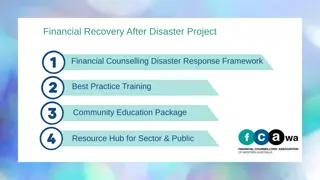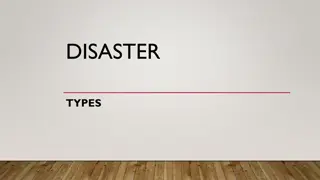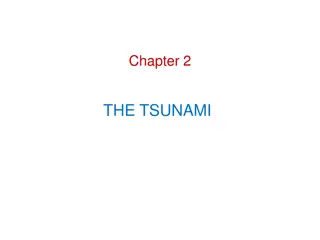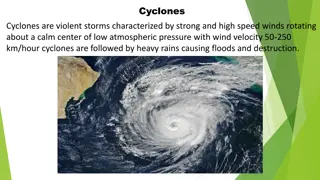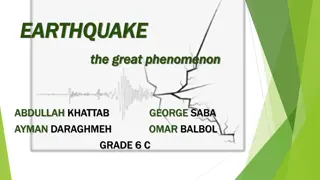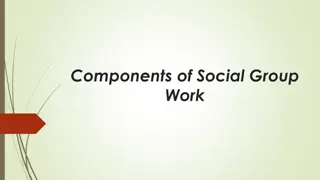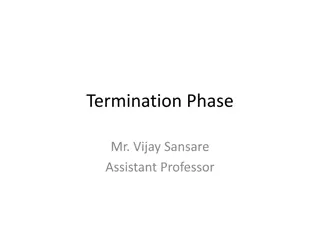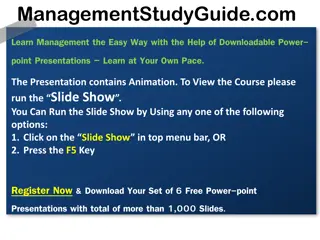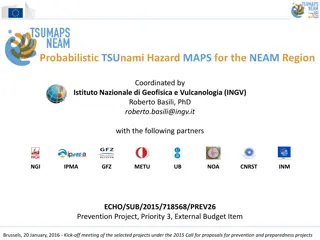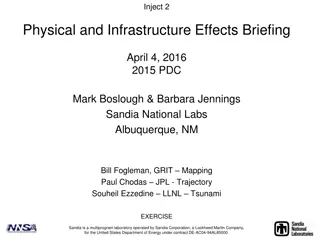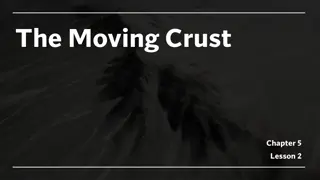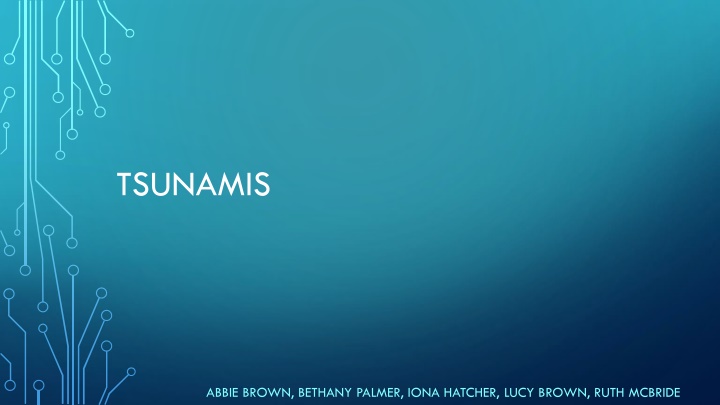
Tsunamis: Definition, Characteristics, Preparation
Learn about tsunamis, including their causes, characteristics, and how to prepare for them. Discover the importance of early warning systems and key steps to take to stay safe in the event of a tsunami. Get valuable insights on how to assemble a disaster supplies kit and effectively communicate with family and friends during a tsunami warning.
Download Presentation

Please find below an Image/Link to download the presentation.
The content on the website is provided AS IS for your information and personal use only. It may not be sold, licensed, or shared on other websites without obtaining consent from the author. If you encounter any issues during the download, it is possible that the publisher has removed the file from their server.
You are allowed to download the files provided on this website for personal or commercial use, subject to the condition that they are used lawfully. All files are the property of their respective owners.
The content on the website is provided AS IS for your information and personal use only. It may not be sold, licensed, or shared on other websites without obtaining consent from the author.
E N D
Presentation Transcript
TSUNAMIS ABBIE BROWN, BETHANY PALMER, IONA HATCHER, LUCY BROWN, RUTH MCBRIDE
A Tsunami is a series of ocean waves called a wave train caused by an underwater earthquake, by a volcanic eruption, landslide, rapid changes in atmospheric pressure, or a meteorite.
TSUNAMIS Can be as long as 100km Can have the continual distance of an hour long Can have waves as high as 100feet Can travel as fast as 5000km/hr Can cross the entire ocean in less than a day (The Indian Ocean- Approx 6400km)
HOW DO YOU PREPARE FOR A TSUNAMI?
Preparation - Most countries have a system alerted when there are signs a tsunami is approaching. A strong earthquake lasting 20 seconds or more Rapid rise or fall in coastal waters A Tsunami WARNING means a tsunami may have been generated and could be close to your area. A Tsunami WATCH means a tsunami has not yet been verified but could exist and may be as little as an hour away. The Pacific's Tsunami Warning System has 3 control centers - Japan, Alaska and Hawaii. When an earthquake strikes, the system analyzes its location and magnitude. If the quake fits the parameters for tsunami-like conditions, a warning is issued to each country within range of danger. The safety of citizens at risk often depends on how advanced the infrastructure in each country is.
The simplest instructions to escape a tsunami are to 1. Go as high and as far as you can ideally to a spot 100 feet above sea level or 2 miles away. 2. Every foot inland or upward may make a difference! 3. If you can see the wave, you are too close for safety. Although brief, these are much easier for residents to remember if they are panicking and working to get to safety quickly. Plans a can be found across the internet on how to deal with all the aspects of a disasters such as this whether that be surrounding family, property. A plan will be different for individuals depending on their circumstances. Tsunami checklist http://www.redcross.org/images/MEDIA_CustomProductCatalog/m4340167_Tsunami.pdf
Assemble a Disaster Supplies Kit Family and Friends Property Spreading the word What to Do When a Tsunami WARNING Is Issued What to Do After a Tsunami
HOW HAVE COUNTRIES BEEN AFFECTED BY TSUNAMIS?
HOW CAN WE DETECT IF A TSUNAMI IS COMING?
HOW WOULD A FAMILY IN SCOTLAND COPE IF THEY LIVED IN AYR?
BEFORE Unknown as no warning sirens or signals Hear through the media Try follow through with instructions, if any given Prepare to evacuate Confusion and panic
DURING Must follow through with any evacuation plans efficiently Head away from sea Not to panic and stay as calm as possible American Red Cross suggest getting to high ground and at least 2 miles away, however, not everyone will know this Buildings are more stable which gives a higher survival rate
AFTER House damage, nowhere to live Floods are very likely Costs Injury Possible loss of family and friends Work/school been effected
EXPERIMENTS THAT CAN BE DONE IN THE CLASSROOM TO TEACH CHILDREN ABOUT TSUNAMIS
How we could appropriately teach this to primary level? Whilst teaching a lesson on a subject such as natural disasters it is important for us as teachers to portray the topic in a discrete and reassuring however informative way. Tsunamis for example could be unsettling for younger pupils to understand and it may be to frightening for them to enjoy the topic as a whole. These type of lesson would be aimed towards pupils in first and second level where they are able to deal handle more serious topics. There are relevant sources of information that can be portrayed to pupils to give them a real life understanding of the issues surrounding tsunamis. Lesson can be tailored to a children s ability to deal with the subject; websites such as weather wiz kids for example can be a useful resource allowing pupils to explore facts, experiments and games surrounding natural disasters. As this is an online source it can used as cross curricular activity within ICT, however classroom experiments could be science related e.g. set up a basin (one side sand, one side water; shaking the tray rapidly to show devastation on a smaller scale).
In conclusion, tsunamis have become a reoccurring natural disaster and it is important that we teach children about them in a way that won t scare them but inform them about what they are and how they are formed. They may also gain a knowledge of how others living in different parts of the world live through these circumstances and what can be done during these disasters to keep safe.
REFERENCES http://www.bbc.co.uk/news/world-asia-30034501 https://www.conserve-energy-future.com/various-tsunami-facts.php http://currents.plos.org/disasters/article/the-human-impacts-of-tsunamis-a-historical-review-of-events-1900-2009-and- systematic-literature-review/ http://www.encyclopedia.com/places/oceans-continents-and-polar-regions/oceans-and-continents/indian-ocean https://pixabay.com/ http://www.redcross.org/get-help/how-to-prepare-for-emergencies/types-of-emergencies/tsunami http://cwarn.org/tsunami/be-prepared
REFERENCES CONT Cwarn.org. (n.d.). Tsunami Early Warning System - Prepare for a tsunami. [online] Available at: http://cwarn.org/tsunami/be- prepared [Accessed 1 Nov. 2017]. American Red Cross. (n.d.). [online] Available at: http://www.redcross.org/get-help/how-to-prepare-for-emergencies/types-of- emergencies/tsunami [Accessed 1 Nov. 2017]. TIME.com. (n.d.). Breaking News, Analysis, Politics, Blogs, News Photos, Video, Tech Reviews - TIME.com. [online] Available at: http://content.time.com/time/world/article/0,8599,1927094,00.html [Accessed 1 Nov. 2017]. Weatherwizkids.com.(n.d.). Weather Wiz Kids | Because weather is awesome. [online] Available at: http://www.weatherwizkids.com [Accessed 1 Nov. 2017].


